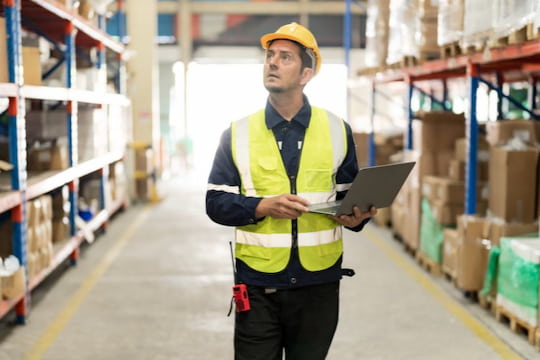As a warehousing employer, workplace safety is likely always on your mind. After all, according to data from the Government Accountability Office (GAO), warehouse injuries have been on the rise in recent years.
Although you likely already take plenty of steps to keep your warehouse operations and employees safe, now is a good time to inventory your safety practices and protocols. If you’re interested in learning more about enhancing safety in warehouse operations, reducing accidents, and ensuring worker safety, below are some warehouse safety tips:
Conduct a Safety Audit

One of the easiest ways to enhance warehouse safety and efficiency is to conduct a safety audit on a routine basis. During this audit, methodically check for safety concerns in each section of your operations.
Are there any items that could be considered tripping hazards? Are emergency exits clear of obstructions? Is warehouse equipment functional and maintained? Are there areas that may pose a fire safety risk?
By conducting an audit, you not only reduce the risk of accidents and injuries but also have the chance to demonstrate to team members your commitment to safety. This can go a long way toward getting others involved in keeping up with safety protocols to create a safe work environment for all.
Make Safety Training a Priority
Enhancing warehouse safety requires your team to know safety protocols and threats. Safety training should be a priority for new hires and seasoned veterans. If you don’t incorporate extensive safety training into your onboarding, now is the time to create training materials.
You should also conduct regular safety training updates so that team members remain up to date and sharp in their knowledge. This is especially true as you add new equipment or new safety threats arise.
Some warehouses also incorporate training for CPR and other medical emergency response situations. If you have safety equipment, such as fire extinguishers or defibrillators, around your warehouse, make sure all pertinent workers know how to properly utilize it.

Provide a Safety Briefing to Vendors and Visitors
Even if you put together safety training and keep your team members up to date on the latest safety concerns, you still need to consider the safety of vendors and visitors. While these people may not require an extensive safety briefing before visiting your warehouse, creating specific safety briefings to provide to vendors and visitors before they are allowed access to your facility may be a good idea.
For example, a vendor may need to know about moving parts in a particular area of your warehouse. Addressing this concern before a vendor enters the area can help reduce accidents and injuries. Visitors may need to be restricted to certain areas or wear identifying vests, badges, or hard hats so that team members can easily tell when a visitor has entered a restricted area that may pose a safety concern.
Don’t Forget About Online Safety
Although workplace safety in the warehousing industry tends to center around physical safety, don’t neglect online safety. As the Internet is used for more and more things these days, and warehousing and logistics professionals rely on connected technologies to get more work done, threats to the digital infrastructure of your warehouse can raise serious concerns. Essentially, any unsecured device on your network that connects to the Internet has the potential to become a safety liability.
As part of your safety protocols and training, ensure you have online safety software installed on connected computers, laptops, and other company devices that interface with the web. You can also conduct online safety training with your team to teach about phishing attacks, ransomware, and other digital risks associated with the use of Internet technology. Enhancing safety in warehouse operations online is just as important as keeping your workers safe on the production floor.
You should also safeguard the safety of personal information collected through your company's website. Not only does this keep sensitive data out of the hands of criminals, but it can also boost customer confidence. To do this effectively, you’re encouraged to include a privacy policy on your company’s website, similar to the one found on the website for Pallets Yesterday, a wood crate manufacturer Fort Pierce trust for pallet solutions.

Hire a Safety Coordinator
Many warehouse owners and managers wear multiple hats and stay busy throughout the day. For some operations, this is fine, but in many cases, those in charge find themselves stretched too thin. When this happens, it can be difficult to keep up with all that needs to be done regarding safety. Unfortunately, the end result is often a rise in accidents and injuries.
To overcome this challenge, consider hiring a dedicated safety coordinator to oversee your warehouse's safety measures. This person may also require a team to complete safety inspections, conduct team member training, handle reporting, and handle other safety-related tasks. Not only does this take these tasks off your plate, but it also allows your warehouse to have a single point of contact through whom safety standards and concerns can be managed.
Review OSHA Guidance
You can also improve warehouse safety by reviewing and following guidance from the Occupational Safety and Health Administration (OSHA). This agency oversees workplace safety regulations, and OSHA guidelines are designed to address general and specific safety concerns.
It’s also worth noting that keeping up with OSHA guidelines isn’t just about keeping warehouse workers safe; it can also keep your company out of legal trouble. OSHA inspectors may levy fines and fees for safety violations, so staying on top of the latest guidance protects your bottom line and your team members.
Warehouse Workplace Safety is Everyone's Responsibility
Regardless of your steps to improve warehouse workplace safety, remember that a team is required to make a real impact. Safety is everyone’s responsibility, and you can only keep workers safe if everyone does their part.
By enhancing safety in warehouse operations by incorporating safety training, routinely inspecting for potential safety hazards, and following official guidance, you’re less likely to experience accidents and more likely to enjoy a safe, efficient workplace.
Contact Pallets Yesterday for Expert Pallet Solutions From Dedicated Professionals
At Pallets Yesterday, we’re proud to be the pallet supplier Fort Pierce, FL, turns to for new, recycled, and custom pallets. Our team can help streamline your operations so you can concentrate on making safety your top priority.
























